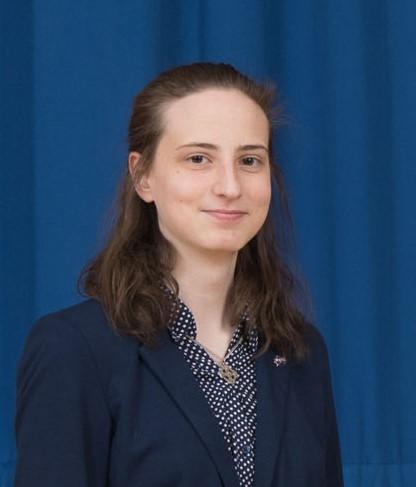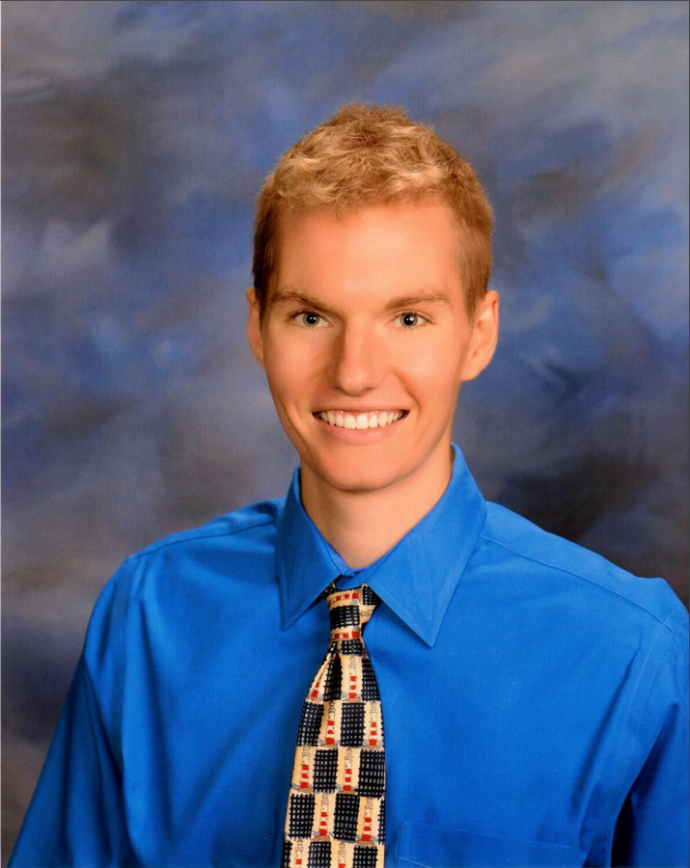January 29, 2021

Mark Lau
"SAE Aero Design: Developing a Highly Competitive System of Systems"
For the past 6 years, Georgia Tech has taken first place at the annual SAE Aero Design Advanced Class competition. The competition objectives are inspired by a Mars colonization mission and tasks teams with prototyping and flying an aircraft capable of accurately dropping water bottles, Nerf Aero Howlers, and autonomous gliders into a 50’ target. The aircraft is subjected to a 11’ maximum wingspan and a 750W power limit. Each glider must carry as many “colonists” (represented by table tennis balls) as possible, glide to and land autonomously within the target zone, and weigh less than 9 oz. Score is determined by payload quantity as well as an optimum ratio between the three types of payload delivered.
The iterative design process includes but is not limited to aircraft sizing, aerodynamics analysis, structural analysis, propulsion system selection, and systems testing. The analysis, modeling, manufacturing, and testing methods refined over multiple years have contributed to overall success. Constant flight testing and a history of learning from failure leads not only to a reliable aircraft system but also to a body of adept students that can compete with confidence. Lastly, a constant cycle of peer student-to-student mentoring ensures continued improvement of the team’s ability to design, build, and fly aircraft rapidly.

Jude Augustine
"Electrical Topology for eVTOL Concept"
The primary focus of this presentation is the development of the electrical topology for a multi-rotor eVTOL aircraft. Motor and battery type and number were already chosen based on powertrain needs. Given the powertrain, the electrical topology is designed to enable safety and low weight. The first important consideration for safety is isolation of motors from one another such that if any component of the powertrain (battery, motor, or inverter) fails, only the opposite motor is potentially affected, preventing failure propagation. Another important safety consideration is ensuring that, in the event of a failure in a circuit, the aircraft continues to maintain full flight control. This is achieved through servos capable of accepting redundant power drawing from two isolated circuits. In addition, servos with redundant motors allow for maintaining control if a servo motor fails. In order to reduce the weight of the circuitry, the power to the ailerons and flaps is carried by the same wires as the power to the motors until near the actuators, where the wires are branched and a DC/DC converter drops the voltage from the motor voltage to the actuator voltage. For actuators that are distant from any motors, such as actuators for tail control surfaces, the DC/DC converter drops the voltage near the batteries, minimizing the wire gauge required to carry power to the actuator.
February 5, 2021

Alex Porter
"ARL Autonomous Drone Docking and Charging System"
The United States Army Research Laboratory (ARL) commissioned a drone-charger interface that can perform fully autonomously. The project is headed by two labs at Georgia Tech. Dr. Jonathan Rogers’ lab has designed an autonomous drone capable of landing on a moving target, while Dr. Anirban Mazumdar’s lab designed and prototyped the charging dock. The landing pad dimensions were optimized in MATLAB using Monte Carlo simulations. The system requirements call for an autonomous charging dock that can charge through the feet of a drone regardless of landing orientation. The system had to be rated for 25 amps to charge 5000 mAh capacity LiPo batteries at 5C. With the optimal design point finalized, the dock frame was equipped with circuitry capable of withstanding the required loads. An Arduino Mega serves as the active controller onboard the drone and dock. Each Arduino is equipped with an XBee radio communication device to synchronize the stages in the charging cycle. In this presentation, I will discuss the charging process, design considerations, fail-safes built into the system, and applications of this system in recon drone missions.
Carly Wood
Currently, rotorcraft shipboard landings are associated with high levels of pilot workload. Various visual flight lead cues for real-time guidance were developed and tested in a pilot-in-the-loop flight simulation. For an approach-turn-land maneuver and an approach-land maneuver, the associated pilot workload is analyzed. A quantitative metric based on time-varying power frequency, and qualitative metrics, NASA Task Load Index (TLX) scores and the Deck Interface Pilot Effort Scale (DIPES), were obtained during the simulation. This presentation will outline the current understanding of the most accurate quantitative versus qualitative representation of this pilot workload data.
February 19, 2021

Edward Eldeiry
"Effect of Heater Location on Horizontal Rijke Tube Hysteresis"
Identifying and mitigating combustion instabilities is one of the biggest areas of research in combustion and propulsion. In doing so, experimental rigs are observed in controlled burning, with temperature, pressure, and other variables tracked and recorded. Often, this raw data undergoes analysis attempts that require plenty of time and programming to do. A better method is to first observe the pressure and temperature data to find hysteresis zones, to narrow down the search for the instabilities. In order to exemplify this metric, a simpler analysis on a horizontal Rijke tube is conducted with preset conditions to find where hysteresis zones may lie.

Ariel Tokarz
"Development of Precision Deployment for the TARGIT Mission’s Tether System"
The Tethering And Ranging mission of the Georgia Institute of Technology (TARGIT mission) is one of the latest CubeSats being developed and built by the Space Systems Design Laboratory at Georgia Tech. The tether subsystem of TARGIT is responsible for deploying tether attached to a target inflatable that will be used for validation and testing of a miniaturized LiDAR instrument. To fulfill all requirements for the subsystem the relationship between deployment speed and hardware specifications was characterized, and a model for proper deployment developed. Following thorough testing, this model was incorporated into the TARGIT mission software for precision deployment of the inflatable target.
March 5, 2021

Andrew Loomis
"Rapid Development of the GT-1 CubeSat Avionics System"
GT-1 is a mission designed to train students in creating and operating a 1U CubeSat bus, in a fast development timeline. The avionics system is integral to mission success, providing the flight computer, attitude determination sensors, radio communications, solar panels, power supply, system monitoring sensors, and more. This presentation will give an overview of the GT-1 mission, avionics design decisions that worked well, and ones that didn’t, along with other important takeaways that may be useful on other small satellite missions.

Jerry Hsu
"Requirements Engineering Focused SysML Modeling of an Unmanned Lunar Mission"
Model-Based Systems Engineering (MBSE) allows for effective representation of complex systems and has become increasingly utilized in the engineering design process. Using SysML (System Modeling Language) in the MagicDraw Tool, MBSE techniques were applied to a mission to characterize the lunar exosphere. This presentation will cover the application specifically from a requirements engineering approach, and emphasis was placed on the modeling of key and driving requirements, as well as the traceability of specific mission constraints originating from the request for proposal. The integration of external environments such as MATLAB and SolidWorks into MagicDraw for verification purposes is also briefly discussed.
March 19, 2021

Austin Hatch
"Creation and Exploration of an MDAO Environment for a Hypersonic Vehicle"
In recent years, the focus on the development of hypersonic vehicles has increased significantly. Though the hypersonic flight regime presents many unique challenges, it also presents a broad range of benefits ranging from reconnaissance to commercial flight. Some of the challenges concerning research in this area include a limited understanding of the highly interdependent physics as well as classified tools pertaining to hypersonic vehicles. In order to address these issues, this Grand Challenge project seeks to create a multidisciplinary design analysis and optimization (MDAO) environment for a hypersonic vehicle using low fidelity and unclassified data and tools.

Nicolas San Miguel
"Sensitivity and Robustness in the Control and Planning of UAVs with Temporal Logic Objectives"
Safe planning and control of multi-drone missions is an important problem for Urban Air Mobility, among other systems, where missions require an Unmanned Aerial Vehicle (UAV) to execute various tasks while satisfying spatial, temporal, and reactive requirements. This presentation will discuss the use of Signal Temporal Logic (STL) to describe the temporal requirements of a multi-UAV mission concisely and unambiguously and will discuss methods for the planning and control of a dynamically feasible vehicle trajectory that satisfies the specified requirements. The controller tracks a UAV along its trajectory with a bounded tracking error which is within a predetermined robustness margin. In addition, this talk discusses the characterization of the tracking error using sensitivity and robustness metrics.
April 2, 2021

Pranav Krishnamurthy
"3-DOF Longitudinal Trim of an Over-actuated eVTOL Aircraft in Transition"
As many companies begin to test prototype eVTOL aircraft, finding the optimal trimmed transition corridor between rotor-borne and wing-borne flight is critical for concepts with tilting rotors and wings. This presentation details the work done as part of a conceptual vehicle design of a eVTOL aircraft at Georgia Institute of Technology. A three degree of freedom model with linear aerodynamic stability derivatives and a surrogate propulsion model was developed for the given aircraft. Interactional effects between rotors and lifting surfaces were neglected during the first development iteration of the tool. The optimizer SNOPT (Sparse Nonlinear OPTimizer) was used to drive the minimization of a specified objective function. Results provide essential insight into the optimal control and constraints of the transition for eVTOL aircraft.

Austin Rose
“The Development of a Hybrid Launch System for Small Satellite Deployment”
With the total number of satellites orbiting earth scheduled to increase by a factor of five over the next few years, the need for a cheaper and more environmentally conscious way of getting to space is more pertinent now than ever before. Given that the typical payload fraction is between 1 and 10%, any reduction in the amount of fuel needed would be significant both financially and environmentally. SpaceShot provides the conceptual development and simulated analysis of a hybrid launch system, from a primary maglev track to a secondary on-board propulsion system, for smaller unmanned missions, mainly the deployment of small satellites.
April 9, 2021

Alistair Sequeira
"Human-Integrated Tool for Proactive and Reactive Security in Cyber-Physical Systems"
As Unmanned Aerial Vehicles (UAVs) and Autonomous Systems (AS) become more prominent, it becomes increasingly important for a security network as well as effective collaboration between human operators and AS. To combat this issue, this presentation provides a comprehensive defense software for cyber-physical systems, comprising both proactive and reactive mechanisms to handle cyber-attacks. Specifically, the demonstrated tool allows a human operator to remain aware of the system’s health and operation, while an autonomous subsystem applies a switching rule based on the principles of Moving Target Defense (MTD). Furthermore, the man-machine interaction implements a trust metric, that allows either the autonomous mechanism or the human agent to have more control over the system based on attack detection and mitigation history. Finally, to demonstrate the tool’s security and collaboration capability, it is simulated using an ADMIRE aircraft.

Ajinkya Sawant
"A Study of Flow Dynamics on A Ballistic Bluff Body Combustor"
The objective of this research is to develop computer models of a reacting flow over a ballistic bluff body at low Reynold’s Numbers. Ballistic bluff bodies are present in a wide spectrum of applications, from industrial boilers to turbojet and ramjet afterburners, and are known for their flame stabilization characteristics. These simulations will be used to inform experimental results conducted in the Ben T. Zinn Combustion Lab and potentially provide more insight on flow fields. Several simulations were run in ANSYS Fluent, each with increasing complexity to achieve this goal. Firstly, Reynolds Averaged Navier Stokes (RANS) laminar and turbulent k-E viscous models were solved to determine the validity of the geometry and resultant solution. With these test-cases validated, unsteady RANS (URANS), k-w SST models were run for a sweep of Reynolds Numbers from 80 to 250. The results from this sweep showed that the Strouhal number, which is associated with the Von Kármán shedding off the bluff body, corresponded closely with that of the well-studied cylinder profile. As the Reynolds number increases, this vortex street grows in magnitude and frequency which can have serious implications for the flame stability. Future study would involve a Large Eddy Simulation (LES) in reacting flow. This additional investigation will be planned to gain insight on the breakdown of local vortices near the flame and irregular oscillations in the flow near lean blowoff conditions. By understanding when and how blowoff occurs with this geometry, the operating ranges of many combustion systems could be expanded and improved.
April 16, 2021

Rohan Patel
"Applying Machine Learning to the Angles-Only Initial Orbit Determination Problem"
As the number of satellites, and amount of debris, in Earth’s orbit continue to dramatically increase further developments in Space Situational Awareness are critical to responsible and safe use of near-Earth space. This presentation will focus on a data-driven approach to the initial orbit determination problem. In particular, development of a machine learning pipeline for real-time initial orbit determination from optical telescope data will be discussed. A convolutional neural network was trained to accept a series of inertially mapped orbits as features and outputted Keplerian orbital elements as labels. The created model was evaluated using both synthetic and real data collected at the Georgia Tech Space Object Research Telescope (GT-SORT).

Sam Winegardner
"Development of a Soft Robotics Tensegrity Rover for Planetary Exploration"
Attained from the term tensional integrity, tensegrity describes a system comprised of isolated components under compression within a tensile network. These tensile forces help stabilize the structure, even when the compression elements experience buckling. Because they are generally lightweight and able to withstand high velocity impacts, tensegrity systems present an interesting possibility of adopting the concept for planetary landing and exploration applications. As a unique and exciting approach towards designing more efficient and cost-effective planetary rovers, the tensegrity rover could be implemented for future missions to Mars, asteroids, and more. This presentation features highlights of the engineering efforts involved in the design and development of a system which enables the tensegrity lattice to move robotically.